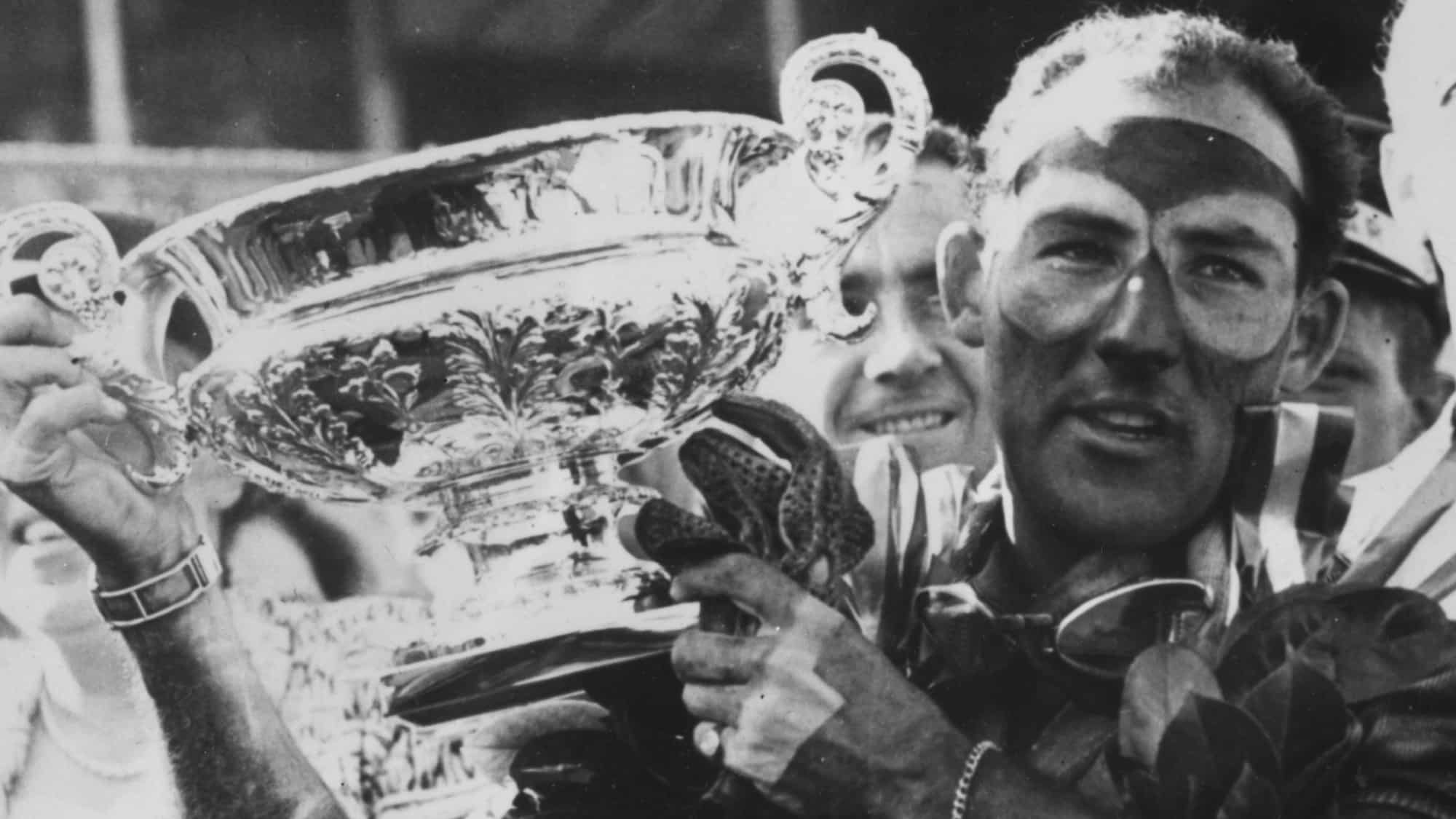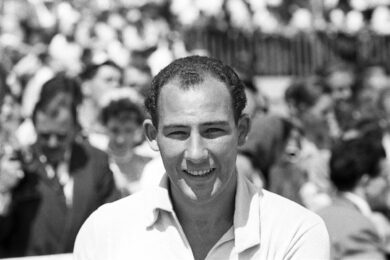Moss had a go to regain the lead as they rounded Tatts Corner but Fangio did not give way, and then on lap 26 he got by at the end of the long straight and it was clear that if Moss was going to be allowed to win, he was going to have to work for it. On the next lap they arrived at Tatts Corner at the same time as McAlpine and he hastily stepped sideways to let them through, nearly stopping in the process. They were still lapping in 2 min. 06 sec. and giving a nice demonstration of good clean driving.
The other two Mercedes-Benz cars still had their satellite Maseratis with them and every one sounded very healthy, but at the back of the field Salvadori had gone out with gearbox trouble and then Collins had the clutch break and coasted the Owen Maserati back to its pit and withdrew. Rolt had had his throttle put right and let Walker set off in the car, while on lap 32 Wharton broke an oil pipe and trailed oil all the way back to the pits to get the car repaired. On lap 37 Musso got by Taruffi once more and this time stayed in front, and Moss had got a 4-sec lead over Fangio, while yet another green car fell by the wayside when McAlpine withdrew his Connaught with a very flat-sounding engine and no oil pressure.
By lap 40 Moss had twice lapped his own Maserati, driven by Macklin. Walker was now having trouble with the dark blue Connaught, and on the next lap Brabham withdrew the Cooper due to engine trouble, and Moss increased his lead to nine seconds due to nipping through some gaps in the traffic, while Fangio had to wait. At half-distance, Moss and Fangio were given the “RG” sign, which means keep stations and carry on at the same lap speeds, and Taruffi was urged to try and get past Musso once more. At this point Macklin, in Moss’ Maserati, spun off at Tatts Corner on the oil spilt by Wharton, and, leaving the car in the straw bales, he walked back to the pits.
Next time round Moss wondered how much it was going to cost him to put it right, and was greatly relieved to see it motoring again after a short time, Macklin having returned with his mechanics and restarted the car. Hawthorn was feeling decidedly unwell due to the heat and handed his car over to Castellotti, and soon after this Schell rejoined the race at the wheel of Wharton’s repaired Vanwall. The comparatively slow Aintree circuit, plus the heat, was taking its toll and as one car rejoined the race so another would fall out, and this time it was poor Mieres who retired in a cloud of smoke, after having driven a spirited race.

Moss holds the trophy having won for Mercedes
Keystone/Getty Images
The leaders were now signalled to slow down and, barring accidents, the race was over, Kling being in a very secure third position half a lap behind, and Taruffi was now fourth, having made a big effort and re-passed Musso, whose car was beginning to show signs of the distance and slowing visibly. Castellotti, in Hawthorn’s car, and Trintignant were having a private dice together until the Frenchman’s car had a plug break up which ruined the cylinder head. Schell began to display the ability of the Vanwall once more and caught and passed Castellotti very convincingly, though many laps behind, finding that the second Vanwall handled far better than his original one. Sparken had the only remaining Gordini running, getting weaker and weaker, but he struggled on and by lap 75 the ten cars that were left running seemed lost on the vast open space that is the Aintree stadium. The end was now in sight, 90 laps being the full distance, and Moss was 4 seconds ahead of Fangio and had lapped everyone except Kling, who was at Bechers Bend as they went past the start. Nose to tail the two short, squat-looking Mercedes-Benz completed the closing laps and as they approached the finishing line, Fangio drew up alongside Moss finishing half a car’s length behind him, just as Moss had done with the sports Mercedes-Benz at the Nürburgring earlier in the season. Kling and Taruffi finished third and fourth, respectively, the former not having blotted his copybook for once and the latter showing remarkable form in his first race with the German car.
After the prize-giving Moss paid a nice tribute to Mercedes-Benz for giving him the opportunity to be the first Britisher to win the British Grand Prix, and especially to Fangio for allowing him to do it. With Mercedes-Benz cars finishing 1-2-3-4 it would seem that their decision to withdraw from Grand Prix racing next year due to lack of opposition is not a wild misstatement.
RESULTS
British Grand Prix — Formula 1 — 90 laps — 435 Kilometres — Very Hot
1st: S. Moss (Mercedes-Benz W196) … 3 hr. 07 min. 21.2 sec. … 139.19 k.p.h. (86.47 m.p.h.)
2nd: J. M. Fangio (Mercedes-Benz W196) … 3 hr. 07 min. 21.4 sec.
3rd: K. Kling (Mercedes-Benz W196) … 3 hr. 08 min. 33.0 sec.
4th: P. Taruffi (Mercedes-Benz W196) … 3hr. 07 min. 36.0 sec. — 1 lap behind
5th: L. Musso (Maserati 250/F.1) … 3hr. 09 min. 29.2 sec. — 1 lap behind
6th: J. M. Hawthorn / E. Castellotti (Ferrari 625) … 3 hr. 08 min. 27.2 sec. — 3 laps behind
7th: M. Sparken (Gordini 1954) … 3 hr. 08 min. 19.0 sec. — 9 laps behind
8th: L. Macklin (Maserati 250/F.1) … 3 hr. 08 min. 28.0 sec. — 11 laps behind
9th: K. Wharton/H.Schell (Vanwall Special) … 3 hr. 08 min. 02.8 sec. — 18 laps behind
Record lap: S. Moss (Mercedes-Benz), in 2 min. 00.4 sec. — 144.37 k.p.h. (89.70 m.p.h.).
Retired: J. Behra (Maserati), R. Manzon (Gordini), H. Schell (Vanwall), E. Castelloti (Ferrari), A. Simon (Maserati), R. Salvadori (Maserati), P. Collins (Maserati), L. McAlpine (Connaught), L. Marr (Connaught), A.P. Rolt (Connaught), J. Brabham (Cooper-Bristol), R. Mieres (Maserati), H. da Silva Ramos (Gordini), H. H. Gould (Maserati), M. Trintignant (Maserati).
*****
As an introduction to the British Grand Prix, the B.A.R.C. occupied the morning with a Formula III race and a sports-car race (divided into capacity classes), each of 17 laps or 51 miles.
The 500s became spaced out along the Aintree straights, for after the first lap, when Russell, Bueb, S. Lewis-Evans and Boshier-Jones were out in front in close company in their Cooper-Nortons, Lewis-Evans and Russell drew well away from the field, to commence an exciting race-long duel. Bueb hung onto Boshier-Jones for a while, then the latter drew away, in third place, until he pulled off the course by the Melling Crossing on lap seven with a run big-end. His Norton engine normally lasts 500 racing miles between overhauls, with a maximum of 7,000 r.p.m., and was just about due for stripping.
Bueb having broken a drive-shaft on lap four, third place was now taken by the South African newcomer. A. J. F. Fergusson and these three dominated the race to the end.
The Russell/Lewis-Evans duel proved the highlight of the race. Lewis-Evans closing right up on lap 13, but after this falling away with a trace of misfiring from his engine. Leston, in Beart’s Cooper-Norton, was a long way behind in fourth place, followed by Allison’s Cooper, while Don Parker’s Kieft was amongst the also-rans on this occasion.
Howard (Cooper-Norton) ran off the course at Anchor Crossing and didn’t restart. Marsh (Cooper-Norton) succumbed to engine trouble, Wicken (Cooper-Norton) was in trouble with gearbox and brakes, and the Ray Martin Special retired with an overheating engine and the Erskine Staride seized-up.
Williams’ Emeryson was lapped twice by the leaders, being passed one on each side by the duellists Leston and Allison on the Railway Straight on lap 16, and Bicknell had his Revis-Norton sideways-on at the corners. So the race ended, with Steve Lancefield-tuned Cooper-Nortons with R. R. Jackson heads in first and third places.
*****
The sports-car race was a great triumph for David Brown’s disc-braked 3-litre DB3S Aston Martins, for after Hawthorn’s tail-finned works D-type Jaguar had led the first two laps, Salvadori took the lead and a lap later Collins was second, while after five laps the Aston Martins were 1, 2, 3, 4 in the order Salvadori, Collins, Walker, Parnell. On lap seven Parnell passed Walker and left him behind, but otherwise, the order remained unchanged, Reg trying hard but unable to catch Collins.
Hawthorn, hampered by a less effective chassis and not in his usual state of fitness, had to be content with fifth place, although driving hard, and far behind the other D-type Jaguars of Berry and Sanderson, the latter the Ecurie Ecosse entry, tagged along. The 2-litre class was depleted early in the race, for Scott-Brown, obviously much fancied, stopped a short way from the line in the familiar Lister-Bristol, and Rogers lost his Cooper-Bristol at Melling Crossing on the second lap, coming very fast into the corner, sliding onto the grass on the right, to shoot across the course, miraculously missing following traffic, to stop against a straw bale protecting a tree, the car half-overturned and badly damaged, and the driver half out of it from the position he had assumed in the passenger’s seat. He was scarcely hurt, and rested until the race ended and he could be taken to hospital for a check-up.
David Hampshire, driving neatly, led in Green’s Lister-Bristol, from Alan Brown in the Gilby Engineering Cooper with Maserati engine, Cliff Davis’ Lotus-Bristol taking third place. However, the 2-litre cars were overshadowed by the 1½-litres, Colin Chapman staging a fine comeback in his M.G.-powered Lotus to lead Hampshire, while McAlpine’s Connaught held off Bueb’s Cooper-Climax, its engine enlarged to 1,200 c.c.
Of the others, Alan Moore’s Lister-Bristol was delayed at the pits after an incident which damaged a wing, Scott-Russell’s Lotus-Bristol lost its fan-belt and Sopwith’s Cooper-Connaught retired with clutch trouble, while Coombs’ Lotus-Connaught, with dual exhaust pipes emerging above the near-side rear wheel, the upper from cylinders two and three, the lower from cylinders one and four, made expensive noises on the warming-up lap, other non-starters being Hamilton’s D-type Jaguar, the other Ecurie Ecosse Jaguar, Crook’s Cooper-Bristol, Keen’s Cooper-Bristol, and Brooks’ Frazer-Nash, so that the race was robbed of some of its interest.


